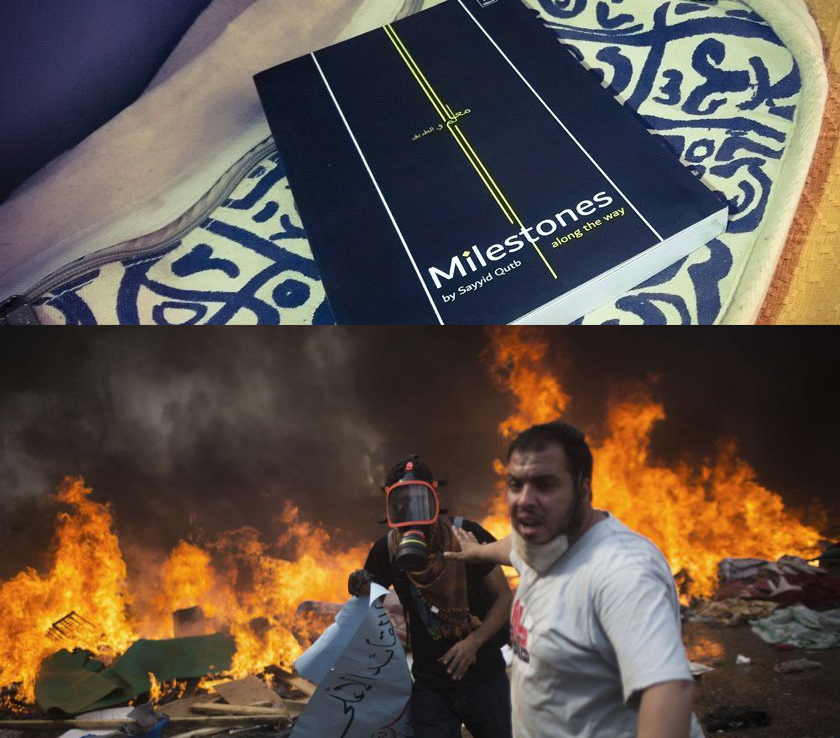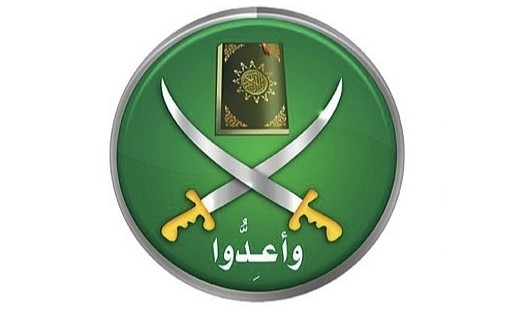Sayyid Qutb (1906-1966), the founder of modern jihadism, wrote of the urgency of forming a group to restore “true” Islam:
It is necessary that there should be a vanguard which sets out with this determination and then keeps walking on the path, marching through the vast ocean of Jahiliyyahh [ignorance] which has encompassed the entire world. 1Sayyid Qutb, Milestones, edited by A.B. al-Mehri (Birmingham, United Kingdom: Maktabah Booksellers and Publishers, 2006), 24.
That group would use all methods including violence to set up an Islamic state:
This movement uses the methods of preaching and persuasion for reforming ideas and beliefs, and it uses physical power and jihad for abolishing the organizations and authorities of the Jahili system which prevents people from reforming their ideas and beliefs. 2Ibid., 65.
The quotes above are from the famous jihadi book by Sayyid Qutb, Milestones (1964). His was the first modern call for violence towards those who oppose the demand to establish an Islamic state and the rule of sharia. Qutb’s “vanguard” idea was not original. In fact, he belonged to one, that is the Muslim Brotherhood. What was unprecedented was his explicit calls for a violent vanguard. Without that “vanguard” idea that preceded Qutb and its materialization into a Muslim Brotherhood in the early 20th century, we wouldn’t have groups like al-Qaeda and ISIS (Islamic State of Iraq and Syria). So who were the Muslim Brotherhood Qutb was a member of?
The Muslim Brotherhood was founded by an Egyptian schoolteacher, Hassan al-Banna, in 1928. At that time, there was a fascination among the literati of the Middle East, and around the world, with Leninism and their communist vanguard. Most likely, that inspired al-Banna to create a similar organization which is meant to include the most dedicated and best educated members in the movement to lead the revolution and protect its gains. His vision also included a political party, like the Bolsheviks, to rule the post-revolution nation.
The Muslim Brotherhood were opposed to the ongoing Westernization of Egyptian and other Muslim societies, and called for the restoration of Islamic values and sharia. They were involved in charitable activities to help the disenfranchised of Egypt. Politically, their first goal was to end the British colonial rule of their home country and ultimately to govern. Islamic charity made them popular among the lower and middle classes, which helped spread their ideas. One of its members assassinated the Egyptian prime minister, Mahmoud an-Nukrashi Pasha. Weeks later, in retaliation, government agents killed al-Banna. King Farouk of Egypt was wary of the growing popularity of the Brotherhood. They supported the king’s overthrow in 1952 by the military officers, one of whom would become President Gamal Abdel Nasser.
During the Nasserite era (1956–1970), they were treated as enemy of the state. He imprisoned most of their leaders, most importantly Sayyid Qutb who was executed. They felt betrayed since they supported the military officers in their coup against the king. The following president, Anwar Sadat, from 1970 to 1981, gave them more freedom. But after his peace treaty with Israel, a group of men, influenced by Qutb’s ideas, assassinated Sadat. Hosni Mubarak, the following president (from 1981 to 2011), continued to fiercely pursue the group, as jihadists associated to varying degrees with the Brotherhood launched terrorist attacks throughout the country. Close to the end of his rule, he allowed some Muslim Brotherhood politicians to run for elections.
Muslim Brotherhood is considered the first politically active and largest Islamist organization. Although they’re considered a terrorist organization in Egypt, Russia, UAE and Saudi Arabia, they still have a global network in 70 countries. They’re opposed to secular and Western ideas. They do not officially condone violence, but many of those who eventually join the violent jihad, pass through their “school” first. In other words, many terrorists are indoctrinated in the Brotherhood brand of Islamism before they join the more extreme Salafi-Jihadism, which itself was inspired by the Brother Sayyid Qutb. Their literature explicitly describes their goal as “the mastery of the world.” Their logo shows two swords and the Arabic word “Prepare.”
After the 2011 revolution, and for the first time in history, they were able to reach the presidency through Mohammed Mursi. One year later, major protests around Egypt led the Military to remove him from office. Today, the group is in crisis, where it once was most active. Egyptian government under Al-Sissi, since 2013, has banned their activities and seized their properties. All leaders have been imprisoned or exiled.
You might also like:

Milestones: The jihadi manifesto in 10 photos
Photos show how a 1964 text laid the foundations of Islamic terrorism
BOOK: MILESTONES

Six types of Muslims in one diagram: Mainstream, Islamists and Jihadists
What is the difference between a Jihadi, a Wahabi and a Salafi Muslim?
BOOK: MILESTONES
Endnotes






